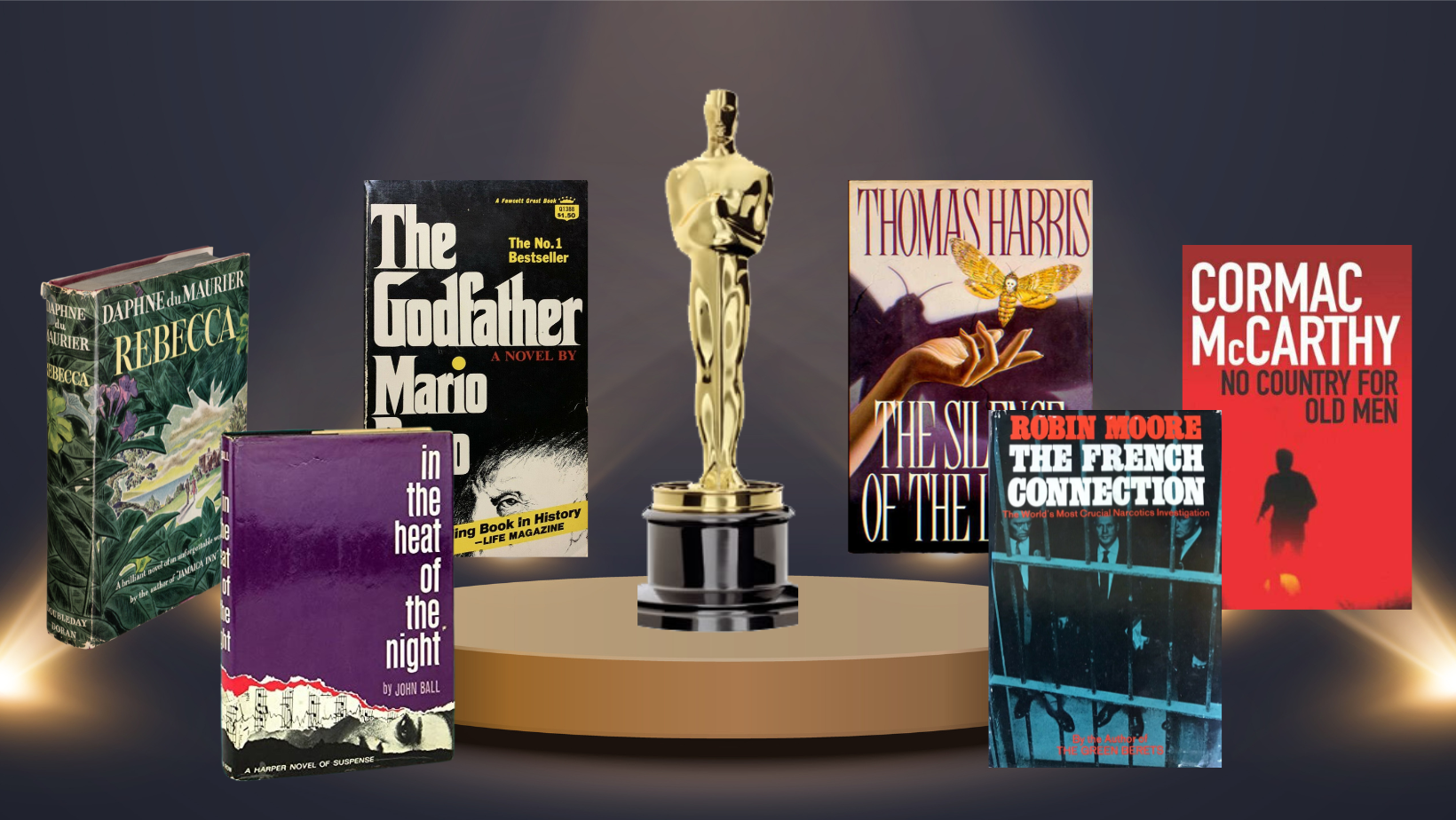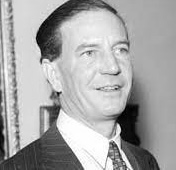Love is in the air, right? Hearts, flowers, Cupid. But Cupid’s arrows can be deadly . . . and some couplings are incendiary.
With that, my recommendation of 10 mystery-crime movies, adapted from books, in which romantic duos—and love triangles—remind us that love doesn’t always conquer all.
1. Double Indemnity (1944)

Barbara Stanwyck is Phyllis Dietrichson, a housewife whose anklet bracelet lets us know that she’s got more on her mind that housekeeping—the better to seductively enlist insurance agent Walter Neff (played terrifically against type by Fred MacMurray) to help her get rid of her hubby.
Double Indemnity is based on a 1936 novella first appearing in the pages of Liberty magazine by hardboiled master James M. Cain. The story was inspired by the real life Snyder-Gray 1927 murder case.
Director Billy Wilder adapted the screenplay with that other crime king, Raymond Chandler. Widely hailed as the ultimate film noir—never mind that it didn’t win any of the Oscars for which it was nominated—Double Indemnity is unique in that we’re in on the scheme from the beginning. No whodunit, it’s a “how are they gonna catch ’em,” as insurance investigator and Neff mentor Barton Keyes (Edward G. Robinson), follows the clues, and his instincts.
Great period details, with famed locales—that’s the beloved Bradbury Building in Downtown L.A., as home to the Pacific All Risk Insurance Company—captured by stunning cinematography, and set to Miklos Rozsa’s brassy score, make this a noir lovers’ Valentine.
2. Body Heat (1981)

“You're not too smart, are you? I like that in a man.” That’s Matty Walker (Kathleen Turner) making a savvy assessment of Ned Racine (William Hurt), the disreputable lawyer who will become her lover, and her partner in a plot to kill her older, wealthy husband (Richard Crenna).
This neo-noir, which marked the debut of writer-director Lawrence Kasdan (today helming Star Wars product), is so obviously inspired by Double Indemnity that we couldn’t not include it in our listing. There’s even a knowing wink with the casting of Crenna, who starred in a 1973 TV movie remake of the 1944 original.
Set during a heatwave in a Florida seaside community, where everyone comments on the sweltering temperatures (and no one turns up the air conditioning!), the film gets a lot of mileage from the R-rated couplings of Hurt and the oft-nude Turner. This was her film debut and springboard into a tenure as a screen siren.
The lush and sultry score by John Barry is the perfect accompaniment to heated passion—and violence—and there’s fine work from the supporting cast, including Ted Danson and J.A. Preston, as a prosecutor and detective, respectively. And look for a young scene-stealing Mickey Rourke as an engaging ex-con who gives Racine advice that he really ought to have taken.
3. The Postman Always Rings Twice (1946)

At first deemed un-filmable by the censors, the story of a drifter who falls for the wife of a highway tavern owner, conspiring with her to kill her husband, teams an incandescent Lana Turner and darkly rugged John Garfield. Their kisses and clinches (which reportedly took place off camera as well as on), were shockers for the day.
As with Double Indemnity, James M. Cain had the 1927 Snyder-Gray case in mind when he wrote his 1934 novel. The book (which has the same title) underwent softening from page to screen, but there’s nothing toned down about Turner and Garfield, who are mesmerizing. Director Tay Garnett worked in multiple genres over a four-decade career, but nothing he did tops this one.
Cain devotees might want to track down two unofficial adaptations—the French Le Dernier Tournant (aka The Last Turning, 1939) and the Italian Ossessione (aka Obsession, 1943). Give the 1981 remake, starring Jack Nicholson and Jessica Lange, a pass. It’s a snooze.
4. Out of the Past (1947)

Deep shadows, overriding pessimism, and an iconic femme fatale make this another noir classic.
The picture benefits from the third teaming of director Jacques Tourneau and cinematographer Nicholas Musaraca; they’d previously done the haunting Cat People (1942) and I Walked with a Zombie (1943). Along with its terrific look, Out of the Past has a complex love triangle—as Kirk Douglas and Robert Mitchum vie for Jane Greer.
Douglas is gangster Whit Sterling. Mitchum is Jeff Bailey, a gas station owner in a mountain community, who used to be known as Jeff Markham, private eye. In a protracted flashback we learn how Markham was hired to find Sterling’s girlfriend, Kathie Moffat (Greer), who fled after stealing $40,000 from him—and shooting him.
Sterling says he has no plans to hurt Moffat. As he tells Markham, “I just want her back. When you see her, you’ll understand better.” The investigation takes Markham to Mexico, where he at last glimpses his target: “And then I saw her, coming out of the sun, and I knew why Whit didn’t care about that 40 grand.”
The story shifts from the present to the past, and back again—and has convoluted plot twists. But there’s nothing perplexing about Kathie Moffat: she is pure evil. In time Jeff tells her, “You’re like a leaf that the wind blows from one gutter to another.”
Geoffrey Homes, unsung crime writer of the thirties and forties (search out the Robin Bishop mysteries), authored the book, Build My Gallows High, on which this is based. Homes was better known as screenwriter Daniel Mainwaring, who is credited with the Out of the Past script. Though there were multiple rewrites from scribes including James M. Cain. Yeah, that guy!
5. Gone Girl (2014)

For a toxic twosome, there’s no topping Nick and Amy Dunne. As depicted by the intrepid Ben Affleck and Rosamund Pike, the Dunnes also score mighty high in the realm of the unreliable narrator.
Director David Fincher knows his way around dark themes. Consider The Girl With the Dragon Tattoo (2011), Zodiac (2007), Fight Club (1999) and (phew!) Seven (1995). With Gone Girl he’s in familiar subversive territory, aided by a crafty screenplay by Gillian Flynn, adapted from her 2012 page-turner.
The story is told from both Nick and Amy POVs—hers from her diary. Are they the happiest couple on earth, save for a few bumps due to career and family woes, or… the most vicious? Amy’s mysterious disappearance, on the couple’s fifth anniversary, puts the union in the media spotlight. Did she meet foul play at the hands of a stranger? Or, as certain revelations come into play, did Nick hurt his wife?
Like Russian nesting dolls, the storyline keeps leading us to side stories—and then layers beneath the layers. Moving it along is the adept cast, including Carrie Coon, Kim Dickens, Neil Patrick Harris and, in a humdinger of a role, Tyler Perry (aka the cross-dressing Madea!) as a high-profile criminal lawyer. And how can we not mention the sinister, throbbing score by Trent Reznor and Atticus Ross, and Amy Dunne’s musings, such as, “He actually expected me to love him unconditionally.”
6. Pretty Poison (1968)

An ad tagline calls Pretty Poison “A shook-up story of the up-tight generation.” That’s as exemplified by Anthony Perkins and Tuesday Weld as mismatched lovebirds, one with a propensity to kill.
Considered an oddity when it was released, the film finds supposedly reformed arsonist Dennis Pitt—who served time for burning down his aunt’s house, with her inside it—working for a chemical plant in a small American town. The overrun is spilling into the local waters; fancying himself a secret agent, Pitt decides to investigate. Then he meets beautiful teenage drum majorette Sue Ann (Weld), whom he christens a kind of junior agent. Like the chemicals polluting the waters, Pitt and Sue Ann are a dangerous combination, and she is especially lethal.
Based on a slender 1967 novel, She Let Him Continue by Steven Geller, the movie came out just a year after Warren Beatty and Faye Dunaway blasted their way into pop culture history as the stars of Bonnie and Clyde. As a result of its timing, some critics saw Dennis and Sue Ann as counterculture outlaws, with the added components of mental illness—and unrepentant violence.
Directed by Noel Black, whose only credit at the time was the short, Oscar-nominated Skaterdater (the first film about skateboarding), Pretty Poison was bolstered by the fact that its producer, Laurence Turman, had just done The Graduate. The screenplay, by Lorenzo Semple Jr, creator of TV’s Batman series, won the New York Film Critics Circle Award.
7. The 39 Steps (1935)

Very loosely adapted from the novel of the same name, a game-changing 1915 thriller, this is the film that, per its director Alfred Hitchcock, “invented the Hitchcock style”—that’s a man wrongly accused, who goes on the run with bad guys and law enforcement in pursuit. Along the way he encounters an icy cool blonde.
The 39 Steps begins with Robert Donat as Richard Hannay, in attendance at a show at London’s Music Hall. A disruption causes the audience to have to exit the building. That’s when a mysterious woman sidles up to Hannay, asking if she can come home with him. He has no way of knowing that the next day he’ll be accused of her murder.
Eluding authorities on a train headed to Scotland, he meets an attractive woman (Madeleine Carroll, the prototype Hitchcock blonde) who refuses to believe his story. They’ll eventually become handcuffed together, emotionally as well as physically. And the chase is on, the beginning of an extremely clever and action-packed mystery, with the requisite cameo by the rotund filmmaker.
The screenplay, by Hitchcock and his then-frequent collaborator, Charles Bennett, makes many changes to the source book, including inventing the blonde (!). But per a 1978 Hitchcock interview, Scottish author John Buchan—Governor General of Canada when the film was made—sent the filmmaker a note, saying he’d improved on the book. In fact, The 39 Steps is a significant work, on paper and on film. The book led to popular sequels, a stage production, a radio play, and multiple remakes. Of Hitchcock’s adaptation, screenwriter Robert Towne (Chinatown) has said, “It's not much of an exaggeration to say that all contemporary escapist entertainment begins with The 39 Steps.”
8. Laura (1944)

The quintessential tale of obsessive love undeterred by death brought acclaim to director-producer Otto Preminger, and earned an Oscar for its lush black and white cinematography by Joseph LaShelle. Based on the novel by Vera Caspary, which was initially a play, the film was one of five American-made crime dramas that so impacted the French film critic Nico Frank that he coined the term film noir. (Double Indemnity was also among that lineup.)
When enigmatic advertising executive Laura Hunt (Gene Tierney) is found dead—a shotgun blast to her face—Detective Mark McPherson (Dana Andrews) questions those who knew her. Their compelling accounts of Laura, and a gorgeous portrait of her, lead to McPherson’s obsessive fascination with the dead woman. And then, after he has fallen asleep at night in her empty apartment, slumped across from the mesmerizing painting, a very much alive Laura enters the room. Thus confounding the mystery.
The stunning Tierney and stalwart Andrews are surrounded by a trio of co-stars who, like heat-seeking missiles, hone in on one another, in a fight for the most vivid screen moments. Clifton Webb is Waldo Lydecker, Laura’s mentor, confidante, and Svengali. He is in love with his creation. So is Vincent Price, as Laura’s smarmy, too handsome fiancé Shelby Carpenter, formerly the gigolo of Laura’s conniving aunt, played by Judith Anderson.
The haunting quality of the eponymous Laura, and Tierney’s portrayal, inspired a hit song that to this day remains as memorable as the film.
9. No Man of Her Own (1950)

Barbara Stanwyck was making a series of melodramas in her early forties, a concession that she was no longer the temptress of her youth. But her acting chops were in no way diminished, as proven by this forgotten noir gem, adeptly directed by Mitchell Leisen.
The film opens with voice over narration that hints at trouble. As Stanwyck’s character, Helen Ferguson relates: “Summer nights are pleasant in Caulfield. They smell of heliotrope and jasmine, honeysuckle and clover. …Oh, yes, the summer nights are pleasant in Caulfield, but not for us. Not for us.”
The story flashes back. Unmarried and pregnant, Ferguson goes to her boyfriend’s apartment. The rat (Lyle Bettger) won’t answer the door, but slips her an envelope containing a train ticket.
Ferguson is on a train, en route to San Francisco when she’s befriended by a married and pregnant couple. They’ve been living overseas, and are on the way to see his family. This will be their first meeting with their son’s wife, Patrice.
The out-of-wedlock pregnancy, a train crash with multiple deaths and a case of mistaken identity follow. And then comes Ferguson’s (well, she’s now known as Patrice) romance with the handsome John Lund. All this might seem soap opera-ish, until the unexpected plot twists (blackmail, a gun...).
The screenplay was based on the book I Married a Dead Man (great title, right?) by mystery maestro Cornell Woolrich under his pseudonym William Irish. The book was itself a reworking of "They Call Me Patrice," a short story that appeared in a 1946 issue of Today’s Woman magazine. Creating a distinctly female-centric noir, the screenplay was written by Sally Benson (Hitchcock’s Shadow of a Doubt) and Catherine Turney (who contributed to the Mildred Pierce screenplay), in collaboration with Leisen.
10. The Thin Man (1934)

To finish this feast we’re raising a glass to mystery film’s ultimate true loves, William Powell and Myrna Loy as Nick and Nora Charles.
The film that introduced the pair in their signature roles, The Thin Man is a hybrid: part drawing room comedy, part mystery, with a lot of witty banter and cocktails, it’s also a character-driven foray. Never mind that we don’t know all that much about Nick and Nora’s background, save that he was a detective in San Francisco, and she inherited “a small-gauge railroad” and “a lot of other things” that Nick now manages. What’s important is that, aside from their dedication to each other, they’re also great at solving crimes, and clever repartee.
The witty, fast-paced script, only loosely based on the novel by Dashiell Hammett, was appropriately from another terrific team, husband and wife Albert Hackett and Frances Goodrich. (For the uninitiated: Nick is not the “thin” man of the title. That’s the person they’re looking for. However, after the film’s success, in subsequent sequels Nick is affectionately known by the moniker.)
The template for all those romantically-teamed crime solvers who once roamed prime-time TV (Hart to Hart, Remington Steele, Castle, and more), Nick and Nora went on to appear in five additional films, a long running radio show and a 1950s TV series.
Clearly, romance and mystery are a winning combination—especially when cocktails are served.
 A regular Mystery Scene contributor, Pat H. Broeske is a veteran journalist-author who has interviewed a slew of film noir greats, including Jane Greer and Robert Mitchum. She still has the swizzle sticks from her extended lunch with Mitchum.
A regular Mystery Scene contributor, Pat H. Broeske is a veteran journalist-author who has interviewed a slew of film noir greats, including Jane Greer and Robert Mitchum. She still has the swizzle sticks from her extended lunch with Mitchum.













 A regular Mystery Scene contributor,
A regular Mystery Scene contributor, 
 John B.
John B. 












 I am sad to report that John Pugmire,
I am sad to report that John Pugmire,  The Truth About the Devlins
The Truth About the Devlins  An Inconvenient Wife
An Inconvenient Wife 
 I feel like you laid out lots of things in Indemnity Only that you are still writing about today, but especially V.I. herself and her relentlessly intelligent and fearless personality. What have you learned about her though 22 books? Does she still surprise you? I also wonder about any blending of personalities. I know you are a writer, not a working private eye, but what qualities do you and V.I. share? In my mind’s eye she looks like you.
I feel like you laid out lots of things in Indemnity Only that you are still writing about today, but especially V.I. herself and her relentlessly intelligent and fearless personality. What have you learned about her though 22 books? Does she still surprise you? I also wonder about any blending of personalities. I know you are a writer, not a working private eye, but what qualities do you and V.I. share? In my mind’s eye she looks like you. In your "Afterword" you mention that you cut out some of the historical letters you had originally wanted to include. Was that a hard decision?
In your "Afterword" you mention that you cut out some of the historical letters you had originally wanted to include. Was that a hard decision?




 Susan Elia MacNeal
Susan Elia MacNeal 




